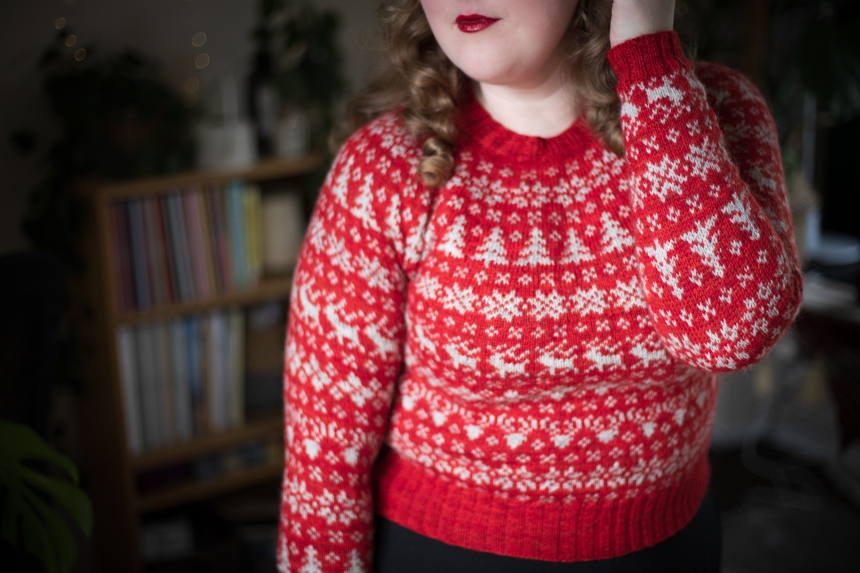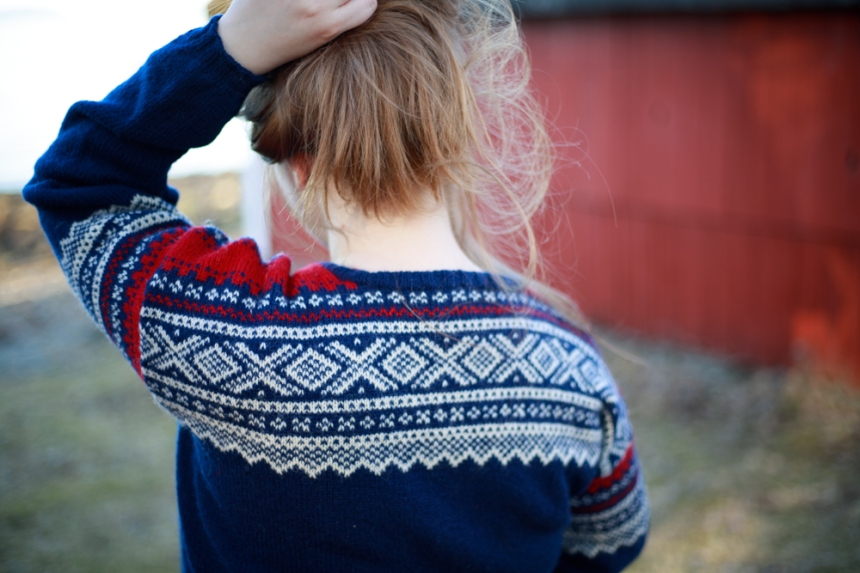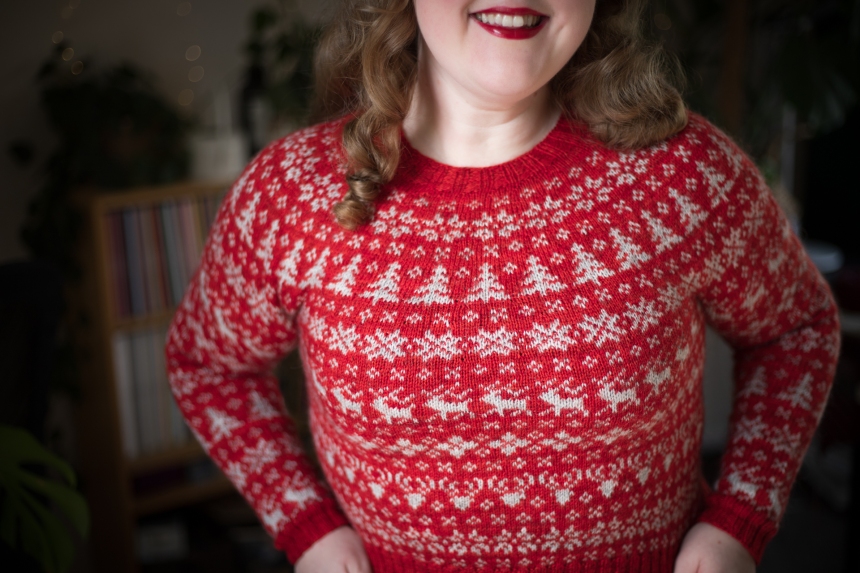
Today I have the very great pleasure of welcoming Eli Leistad – better known in the knitting world as Skeindeer – to the KDD blog. I’ve admired Eli’s fresh and thoughtful approach to design for several years, and her glorious two-tone colourwork – often inspired by Norwegian design and textile history – offers a feast for the eyes as well as warmth for the body and its extremities. Eli’s annual mitten clubs are extremely popular among my KDD colleagues, and the patterns she has created for this year’s club – taking a knitting journey around several Nordic countries – are particularly inspiring. I was so happy when Eli agreed to write a post for us about the colours of Norwegian knitting. I often find myself thinking about how our perceptions of the past are affected by viewing images in monochrome: a theme which Eli touches on – and much more – in what follows.

When I left Norway for London over 11 years ago, I quickly started to miss Norwegian knitting. I wanted to make myself a classic Marius jumper in red, white, and blue. The most Norwegian knit garment I could think of. You can probably find one in most Norwegian households. And I made several!

This flag-coloured jumper became a huge hit in the 1950s knitting-boom of post-World War II Norway. The country reignited its national identity following a half a decade-long occupation by Nazi Germany. Prior to this oppressive regime, Norway had only enjoyed 35 years of independence from a near century-long union with Sweden and over 4 centuries under Danish rule. Finally, Norway was its own country, and the red, white, and blue Marius jumper fit right into that zeitgeist. These colours have hugely influenced what we think of as Norwegian knitting colours since.

Like much of my own design work, this mid-century knitting-boom was inspired by Norwegian knitting from the 1800s. The Marius jumper itself is derived from the Setesdal lusekofte. But the Setesdalkofte was made in naturally black and white sheep wool.

Much of early Norwegian colourwork knitting was made in natural colours, as dyeing was time and cost prohibitive. Even white yarn was expensive until the introduction of sheep breeds with white fleece at the end of the 1800s.

Nothing has inspired my work more than Selbu mittens. Today these mittens are recognised world-wide for their black and white colourwork. But in the mid-1800s they were central in the wedding rituals in the village of Selbu. Because these were finer stas mittens they could be made with more costly yarn – even dyed yarn.


At the time, red and blue Selbu mittens were not uncommon, although blue dye was particularly expensive. The mittens would often be made in undyed white and black yarn, and then dyed red. Although many think of black and white Selbu Mittens and Lusekofter, or the flag-coloured Marius as typical Norwegian knitting colours, this use of red with a dark colour is to me the true Norwegian knitting palette.


Norwegian knitting was not really a term until Annichen Sibbern Bøhn’s book in 1929. This was the first Norwegian knitting book, featuring both the Setesdal lusekofte as well as Selbu mittens.

The book was hugely influential on the mid-century Norwegian knitting-boom. However, none of the charts or photos had any colours in them.


Items of historical Norwegian knitwear are often photographed in greyscale, biasing our perception of Norwegian knitting as colourless as well. My Haldogard pullover and cardigan were greatly inspired by a greyscale photograph of the Haldogard fisherman’s sweater. I used soft plant-dyed colours by Danish G-uld. However, the original Haldogard was actually made in black and bright red.

While it is true that dyed wool was expensive and working with natural colours was widespread, Norwegian knitters still used colour. Especially red. I don’t have a photo of Haldogard in colour, but the Torridalskofte is another great example of how drastically different a red and black colourwork garment can look in grayscale and in full colour. Sometimes dark blue was used instead of black.

It appears I have come around full circle, returning to red, white and blue as characteristic colours of Norwegian knitting. But I think it’s important to note that the preference for these colours goes back much further than the 1800s widespread use of colourwork in knitting, or the introduction of the Norwegian flag in 1921. Although drastically different from the communities I grew up in, Norwegians in the 19th century were a deeply superstitious and god-fearing people.
Clothes weren’t just practical garments, but also spiritual tools. The use of colours in textiles was more than aesthetic choice, and had its foundations both in Christianity and old heathen practices.
- Black was a colour of sorrow as well as witchcraft and sorcery. Using black and very dark blue was supposed to protect against the dangerous and unknown darkness.
- White represented virtue, purity, and holiness, and offered the wearer healing, protection, fortune, luck, love and fulfilment.
- Blue symbolised the sky and the ocean. It was the colour of the Virgin Mary, and considered a precious and distinguished colour as indigo dyeing was rather time and cost prohibitive.
- Red represented fire, blood, life, suffering and struggle. Despite the cost and time of dyeing yarn, it’s no wonder the use of red was so widespread. The rural Norwegian knitters of the 19th century were highly religious, and red represented the blood, love, and sacrifice of Christ.

Notice how the original men’s jumpers in the illustrations I’ve included in this post were knitted in plain white wool from the waist down. Although previously thought to not waste colourwork on what would be tucked inside the trousers, Annemor Sundbø argues that white wool was too precious to be used that way. More likely, the white was supposed to protect from the darkness in the trousers and keeping symbol-heavy colourwork away from taboo areas of the body.

I love learning about the colour symbolism of historical Norwegian knitting. Because I believe that we must learn the rules so that we can break them. And we must break them so that we can move on and make something new. For instance, in the past, only men wore colourwork garments and colourwork-cuffed Selbu Mittens. But over time, these beautiful handknits have become something that everyone can wear, and this has opened the creative possibilities far and wide.

So while I don’t adhere to the traditional colour symbolism, I often return to the old black, white, blue, and red colour palette. It’s an aesthetic nostalgia that gives me the warm and fuzzies away from home. And other times I incorporate colours outside of this palette, using favourites like mustard yellow, burgundy purple and bottle green. These are some of the ways I enjoy using colours: drawing upon the old, to create something new.

Thank you so much, Eli! You can find Eli’s wonderful designs in her Ravelry store, follow her on YouTube and IG, and sign up for her newsletter here
Further Reading
A. Bårdsgård: Selbumønster
A. Bårdsgård: Selbuvotter
A. Kjellberg et al: Strikking i Norge
I.G. Klepp & T.S. Tobiasson: Norsk Strikkehistorie
A. Sibbern: Norsk Strikkemønstre
A. Sundbø: Koftearven
A. Sundbø: Spelsau og Samspill
A. Sundbø: Usynlege Trådar i Strikkekunsten
N.G. Sæther: Norske Strikketradisjoner


I’ve long loved Eli’s designs and it’s fascinating to learn the background of Norwegian colorwork and knitting traditions. Thank you!
LikeLike
I love this color series, Kate. Your guest posts and so many interesting articles are such an inspiration.
Thank you so much for introducing us to Eli and all the color stories.
LikeLike
Another great essay & wonderful guest knitter & designer. Thank you Kate, & thank you Eli. The diversity of colour-related topics in the Allover club has been amazing; it’s taken us all on a fascinating & enlightening journey in history, culture, art, nature, food & more, & all relating back to colour. Have loved it!
Eli, I really enjoyed reading the history & symbolism of Norwegian knitting & its use of colour & why. Unfortunately, in my Australian schooling through the 50’s, 60’s, & 70’s there was little to no Norwegian content. So my knowledge has been scant here, but having read your essay, I am keen to read more on Norway in general.…& it’s particularly its knitting . I love your designs & am now a keen follower of Skeindeer!
LikeLike
Another great article. I love reading about the symbolism of the colours, it’s fascinating that colour has so many meanings, especially the idea of the white at the bottom of the jumper. Off now to browse patterns.
LikeLike
Thank you. Lovely designs. I bought both the Bardsgard books as they came out – so very useful for anyone who likes the challenge of designing their own.
LikeLike
When I was a teenager living in Iceland, it seemed like everyone had a Norwegian Marius sweater except me. I always wanted one but I didn’t know how to get one. Probably my classmates all had mothers and grandmothers who knit these sweaters for them, but my parents being American weren’t hip to the scene. Maybe I’ll finally make one for myself now. I recently had the privilege of meeting Annemor Sundbø while in Norway. She’s a national treasure.
LikeLike
It is always great to see Eli’s designs and essays about Norwegian knitting design. Some of the books in the Further Reading list are available in English:
A. Bårdsgård: Selbumønster – Selbu Patterns (Trafalgar Square Books, 2021)
A. Bårdsgård: Selbuvotter – Selbu Mittens (Trafalgar Square Books, 2019)
A. Sibbern: Norsk Strikkemønstre – Norwegian Knitting Designs (a copy of this is included with Norwegian Knitting Designs – 90 Years Later by Wenche Roald and Annichen Sibberb Bøhn, Trafalgar Square Books, 2020)
A. Sundbø: Koftearven – Norway’s Knitted Heritage (Schiffer Publishing, forthcoming in May 2023)
A. Sundbø: Usynlege Trådar i Strikkekunsten – Invisible Threads in Knitting (Torridal Tweed, 2007)
N.G. Sæther: Norske Strikketradisjoner- This book is not in English but several other pattern books by Nina Granlund Sæther are published by Trafalgar Square Books and include short histories/stories of the accessory designs (socks, mittens, shawls)
LikeLike
Thank you for expanding my knowledge of Norwegian knitting even further. So many patterns added to my wish list!
LikeLike
A new book was delivered the day before this blog. The book is Knitted Kalevala by Jenna Kostet and is a real compliment to Eli’s writing. I will follow Eli and am anxious to do some two colour colourworks patterns.
LikeLike
Thank you, Kate, for this introduction to Skeindeer creativity. I have long been a fan of Norwegian knitting, but realize now that there is even more to learn. Putting future investigations high on my list of New Year’s resolutions Cheers!
LikeLiked by 1 person
Thanks Kate😊I loved the history & haven’t done Norwegian knitting in a good while. My appetite is whetted.
LikeLike
There’s some wonderful stories behind traditional patterns, nearly all of which I was completely unaware of until this inspirational club and it’s bloggers.
Thank you Kate and everyone!
LikeLiked by 1 person
After I read this post, I immediately signed up for Eli’s newsletter. Her patterns tell delightful stories. As an immigrant, I am particularly inspired by Eli’s writing on how people around the world find a way to stay connected to their roots, their culture, through knitting traditions, colors and patterns.
LikeLiked by 1 person
What a wonderful article. I learned so much and the design work is amazing! Thank you for introducing us to Eli and of course I am now following her work.
LikeLiked by 1 person
When Norway was the guest of Honorar on Frankfurt book fair in 2019 I learn about Selbu mitten and the Norway knitting tradition so inspiring. Thanks for this article.
LikeLiked by 1 person
I hadn’t heard of Eli before so this has been a delight! I’m off to her Ravelry store! Such beautiful work and stories attached. Thank you. Off to explore……..
LikeLiked by 1 person